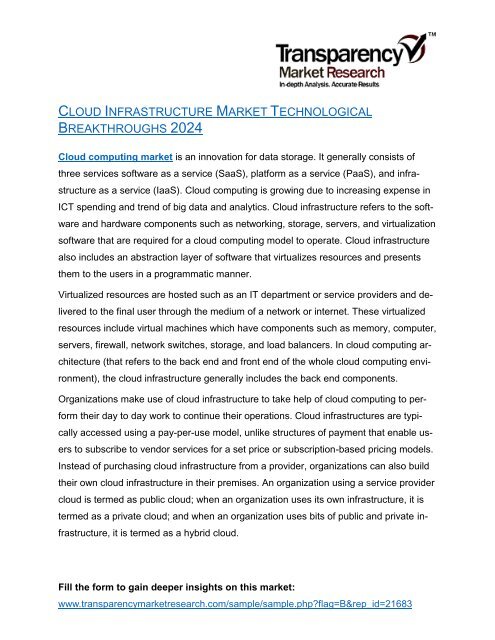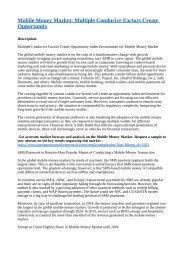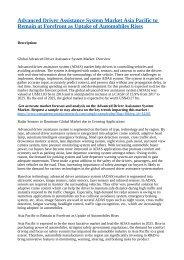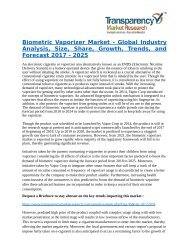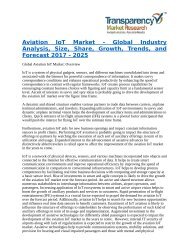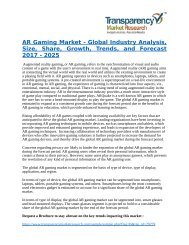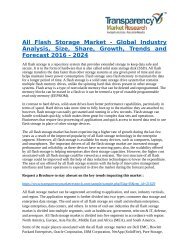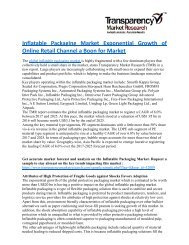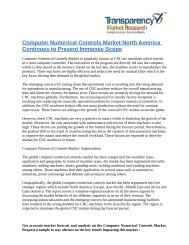Cloud computing market
Cloud Infrastructure Market is boosted by mobility of data accessibility, business continuity, cost saving from buying physical storage devices, and on-demand business scalability; cloud infrastructure market can be divided into hardware components, software, and application
Cloud Infrastructure Market is boosted by mobility of data accessibility, business continuity, cost saving from buying physical storage devices, and on-demand business scalability; cloud infrastructure market can be divided into hardware components, software, and application
Create successful ePaper yourself
Turn your PDF publications into a flip-book with our unique Google optimized e-Paper software.
CLOUD INFRASTRUCTURE MARKET TECHNOLOGICAL<br />
BREAKTHROUGHS 2024<br />
<strong>Cloud</strong> <strong>computing</strong> <strong>market</strong> is an innovation for data storage. It generally consists of<br />
three services software as a service (SaaS), platform as a service (PaaS), and infrastructure<br />
as a service (IaaS). <strong>Cloud</strong> <strong>computing</strong> is growing due to increasing expense in<br />
ICT spending and trend of big data and analytics. <strong>Cloud</strong> infrastructure refers to the software<br />
and hardware components such as networking, storage, servers, and virtualization<br />
software that are required for a cloud <strong>computing</strong> model to operate. <strong>Cloud</strong> infrastructure<br />
also includes an abstraction layer of software that virtualizes resources and presents<br />
them to the users in a programmatic manner.<br />
Virtualized resources are hosted such as an IT department or service providers and delivered<br />
to the final user through the medium of a network or internet. These virtualized<br />
resources include virtual machines which have components such as memory, computer,<br />
servers, firewall, network switches, storage, and load balancers. In cloud <strong>computing</strong> architecture<br />
(that refers to the back end and front end of the whole cloud <strong>computing</strong> environment),<br />
the cloud infrastructure generally includes the back end components.<br />
Organizations make use of cloud infrastructure to take help of cloud <strong>computing</strong> to perform<br />
their day to day work to continue their operations. <strong>Cloud</strong> infrastructures are typically<br />
accessed using a pay-per-use model, unlike structures of payment that enable users<br />
to subscribe to vendor services for a set price or subscription-based pricing models.<br />
Instead of purchasing cloud infrastructure from a provider, organizations can also build<br />
their own cloud infrastructure in their premises. An organization using a service provider<br />
cloud is termed as public cloud; when an organization uses its own infrastructure, it is<br />
termed as a private cloud; and when an organization uses bits of public and private infrastructure,<br />
it is termed as a hybrid cloud.<br />
Fill the form to gain deeper insights on this <strong>market</strong>:<br />
www.transparency<strong>market</strong>research.com/sample/sample.php?flag=B&rep_id=21683
<strong>Cloud</strong> infrastructure empowers the organization or company to manage traditional workload<br />
data by using an open private cloud deployment model. Organizations deliver<br />
cloud constructed cohesive infrastructure as a service in order to make new investments,<br />
technologies, and upgrade to better capture and position them in the <strong>market</strong> and<br />
to improve manageability. <strong>Cloud</strong> infrastructure services are generally used across all<br />
major verticals such as government, telecom, healthcare, banking, manufacturing, financial<br />
services, and others. The global adoption rate of cloud infrastructure services is<br />
increasing due to the growing implementation rate in Asia Pacific, Middle East & Africa,<br />
and Latin America regions.<br />
Major drivers of the cloud infrastructure <strong>market</strong> are mobility of data accessibility, business<br />
continuity, cost saving from buying physical storage devices, and on-demand business<br />
scalability. Thus, demand for cloud infrastructure is set to grow in the near future<br />
due to increase in demand for cloud <strong>computing</strong>.<br />
However, infrastructure complexity, data security implications, and limited control of<br />
cloud resources are acting as the restraints of the global cloud infrastructure <strong>market</strong>.<br />
The cloud infrastructure <strong>market</strong> can be divided into hardware components, software,<br />
and application. Hardware components are generally categorized as servers, computers,<br />
storage devices, memory, and CPU among others. The software segment can be<br />
divided into Ajax, and Ruby on Rails. The application category can be further divided<br />
into private cloud & hybrid cloud, backup, disaster management, big data analytics, file<br />
storage, and test & development.<br />
In terms of region, the cloud infrastructure <strong>market</strong> is divided into North America, Europe,<br />
Asia Pacific, and Rest of the World. North America led the cloud infrastructure <strong>market</strong><br />
followed by Europe, Asia Pacific, and Rest of the World.
The major players in this industry are Hewlett-Packard (U.S.), AWS (Amazon Web Services)<br />
(U.S.), Dell, Inc. (U.S.), Cisco Systems, Inc. (U.S.),Quanta Computer Inc. (Taiwan),<br />
Foxconn Technology Group (Hon Hai Precision Industry Co., Ltd.) (Taiwan), Intel<br />
Corporation (U.S.), and NetApp, Inc. (U.S.) among others.<br />
The report offers a comprehensive evaluation of the <strong>market</strong>. It does so via in-depth<br />
qualitative insights, historical data, and verifiable projections about <strong>market</strong> size.<br />
About Us<br />
Transparency Market Research (TMR) is a global <strong>market</strong> intelligence company providing<br />
business information reports and services. The company’s exclusive blend of quantitative<br />
forecasting and trend analysis provides forward-looking insight for thousands of decision makers.<br />
TMR’s experienced team of analysts, researchers, and consultants use proprietary data sources<br />
and various tools and techniques to gather and analyze information.<br />
TMR’s data repository is continuously updated and revised by a team of research experts so that<br />
it always reflects the latest trends and information. With extensive research and analysis<br />
capabilities, Transparency Market Research employs rigorous primary and secondary research<br />
techniques to develop distinctive data sets and research material for business reports.<br />
Contact Us<br />
Transparency Market Research<br />
State Tower,<br />
90 State Street, Suite 700,<br />
Albany NY - 12207<br />
United States<br />
USA - Canada Toll Free: 866-552-3453<br />
Email: sales@transparency<strong>market</strong>research.com<br />
Website: http://www.transparency<strong>market</strong>research.com


